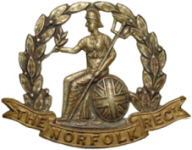



No.202164, Private, Bert John ROGERS
Aged 19

|
Bertie John Rogers was born on 11th January 1898 in Livermere (Thingoe Q1-1898 4A:826), baptised in St Peter's, Great Livermere, son of John and Jane
Susan ROGERS (née WELLS).
1901 census...Aged 3, he was at Old Farm, Little Livermere with his father John ROGERS [34] farm labourer born Pakenham; his mother Jane [24] born Whepstead and brother Sidney T [1] born Little Livermere. 1911 census...Aged 13, he was in Ampton with his father John ROGERS [39] labourer in woods born Pakenham; his mother Jane Susannah E [36] born Whepstead; brothers Bertie John [13], Sidney Thomas [12] and sister Victoria Daisy [9] all born in Little Livermere, brothers Robert Victor [7], Arthur William [5] and Percy Samuel [3] all born Ampton. There was another brother, George [14] born Fornham St Martin, who was with his grandparents, Henry and Eliza MUSK, at School Lane, Fornham St Martin. His younger brother Percy Samuel was to die at the surrender of Singapore in February 1942 see here |

|
He attested in Bury St.Edmunds on 2nd March 1916 and was mobilised on 10th October 1916. He gave his date of birth as 11th January 1898, a wood worker living
in Ampton. He was 5 feet 2.25 inches (158 cm)tall, weighed 108 lbs (49.1 kg), chest 32" to 35" (81.3 to 88.9 cm). Initially No.7487 4th Battalion, he left Folkestone for Boulogne on 29th March 1917.
He was at Infantry Base Depot on 30th March and then posted to 7th Battalion, Norfolk Regiment as No. 202164 on 16th April 1916, only to be posted missing and
presumed dead on 28th April.
On the 28th the objectives were (1) RIFLE TRENCH and BAYONET TRENCH (Black line) and (2) the BLUE LINE (shown below). The war diary of the 7th Norfolks has:- " At 4:25 am this morning "C" and "D" companies- "C" on the right- advanced to capture RIFLE TRENCH and join up with "A" and "B" Companies. In conjunction with the attack of the 5th R.Berks Regt, this would establish the BLACK LINE. At zero plus 50 minutes - the BLACK LINE being captured, all the four companies of the 7th Norfolk Regt with the 7th Suffolk Regt on their left should have proceeded to establish a map line...(given below) to be called the BLUE LINE. At 2 pm no definite news had been received regarding the attack. It appeared that "A" and "B" Coys went over the top at zero plus 50 minutes without gaining touch with "C" and "D" Coys and were lying out in front in shell holes, having been entirely held up by M.Gun fire with both their flanks unprotected. "C" and "D" Coys were unlocated. Some men of "A" and "B" Coys began to crawl in, back to our line but were at once sniped. At 11 pm the situation is as follows. The Attack by "C" and "D" Coys was held up by M Gun and rifle fire - none of our men reached the German line. The trench had not been touched by artillery and there was some wire. For the remainder of the day our men lay out in shell holes being sniped by the enemy. As soon as it was dark all those that could, returned to our lines and stretcher squads went out to bring in the wounded. For the whole of their work they were continually under enemy M.Gun and rifle fire, which was done with the aid of extremely bright Very lights. The fire was so heavy and so accurate that is was impossible to bring in many of our men who were badly wounded and close to the enemy trench. The casualties of "C" and "D" Coys are very heavy." Two days later a fresh attack did succeed in taking Rifle Trench, but a counter attack drove them back. CWGC records show 72 of the battalion killed on 28th, only 7 with identified graves. map from "familyatwar" photo: Commonwealth War Graves Commission click here to go to the Commonwealth War Graves Commission website for full cemetery/memorial details |